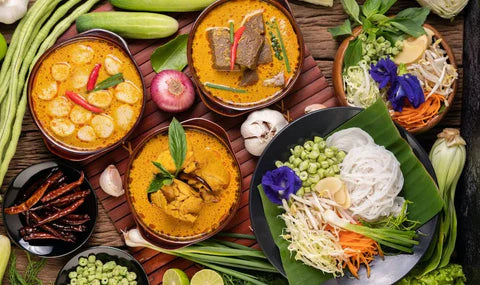
Historic Asian influence in our Cape Town food
Share
Exploring the Asian-South African Culinary Fusion in Cape Town
Cape Town’s culinary scene is a vibrant mosaic, and the Asian-South African fusion stands out as a dynamic thread, blending the bold, aromatic flavors of Asia with South Africa’s diverse ingredients and cultural influences. This fusion reflects the historical presence of Asian communities—particularly Indian, Chinese, and Malay descendants—whose culinary traditions have been woven into the city’s food fabric, creating dishes that are both innovative and deeply rooted in heritage.
A Historical Blend
The Asian influence in Cape Town’s food culture traces back centuries, primarily through the Cape Malay community, descendants of enslaved and indentured laborers from Indonesia, Malaysia, and India brought by Dutch colonizers. Their culinary legacy, combined with later waves of Chinese and Indian immigration, has shaped a unique Asian-South African identity. Indian South Africans, largely concentrated in areas like Durban but influential in Cape Town, introduced spices and techniques that permeate dishes like curries and samoosas. Chinese communities, though smaller, added stir-fry methods and umami-rich flavors, while Cape Malay cuisine brought fragrant spice blends and slow-cooked stews.
Signature Dishes and Flavors
One standout dish in this fusion is the Cape Malay curry, a cornerstone of Asian-South African cuisine. Unlike the fiery curries of India, Cape Malay curries are milder, aromatic, and often sweetened with fruit chutneys or raisins. Take, for example, a chicken curry served at Bo-Kaap eateries: tender chicken simmers in a sauce of turmeric, cumin, coriander, and cardamom, with a touch of sweetness from dried apricots. The flavor profile is warm and layered—spicy yet soothing, with a creamy texture from coconut milk or yogurt. Served with roti or fragrant rice, the dish balances soft, yielding textures with the occasional crunch of toasted spices.
Another gem is the bunny chow, a South African-Indian creation that’s gained traction in Cape Town. This street food classic features a hollowed-out bread loaf filled with curry—often mutton or vegetable—its crusty exterior soaking up the rich, spicy gravy. The texture contrast is key: the bread’s chewiness meets the tender meat and velvety sauce, while flavors range from fiery chili to cooling cucumber raita on the side. Places like Eastern Food Bazaar in the city center serve these with flair, offering a taste of Durban’s Indian influence right in Cape Town.
Chinese-South African influences shine in dishes like sweet-and-sour pork, adapted with local ingredients. At restaurants like South China Dim Sum Bar, you’ll find crispy pork bites tossed in a tangy sauce with pineapple and peppers, blending umami depth with bright, sweet notes. The texture is a delightful interplay of crunchy batter and juicy meat, reflecting Chinese stir-fry techniques tailored to South African palates.
Textures and Composition
The Asian-South African culinary scene is a masterclass in texture and composition. Consider samoosas, a ubiquitous snack with Indian and Malay roots. These triangular pastries, filled with spiced mince, lentils, or vegetables, offer a crispy, flaky shell that gives way to a soft, savory interior. The spices—cumin, coriander, and sometimes fennel—create a warm, aromatic flavor that’s bold without overwhelming, often paired with a zesty chutney for dipping.
Desserts also showcase this fusion. Koeksisters, a Cape Malay treat, are dough twists deep-fried to a golden crunch and soaked in sweet, spiced syrup infused with cinnamon or cardamom. The result is a sticky, chewy exterior with a soft, syrupy core—a textural delight that marries Malay sweetness with South African flair.
Where to Experience It
Cape Town’s food markets and restaurants are hotspots for this fusion. The Neighbourgoods Market in Woodstock features stalls like Bamboo Eatery, where Asian-inspired dishes incorporate local game meats, such as springbok in a soy-ginger glaze. Fine dining venues like FYN elevate the fusion with dishes like miso-glazed fish, where delicate, flaky textures meet umami-rich sauces, paired with South African wines for a modern twist.
Food tours, such as those by Cape Malay Cooking Safari, immerse you in Bo-Kaap’s kitchens, where you’ll learn to grind spices for a tomato bredie (stew) or fold samoosas, connecting with the cultural stories behind each dish. Posts on X highlight the popularity of these experiences, with locals raving about the “unforgettable” flavors of home-cooked Cape Malay meals.
Why It Matters
Cape Town’s Asian-South African cuisine isn’t just about food—it’s a celebration of resilience and adaptation. As the city ranks among the world’s top culinary destinations in 2025, this fusion stands out for its ability to blend global influences with local ingredients, creating dishes that are both nostalgic and forward-thinking. From the crunch of a samoosa to the velvety warmth of a curry, every bite tells a story of heritage, innovation, and the shared joy of eating in Cape Town.
